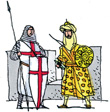 Beit Hatefutsoth
Beit Hatefutsoth
(Museum of the Jewish People, est. 1978), located on the Tel Aviv
University campus, uses modern techniques and audio-visual displays to
trace the history of Diaspora Jewish communities through the ages and
throughout the world. In this non-artifact museum, exhibitions are
arranged thematically, and each floor has a study area. Temporary
exhibits on Jewish subjects, a chronosphere presenting an audio-visual
overview of Jewish history and a full range of educational and cultural
programs and travelling exhibitions are also regularly featured. The
Web site also offers advice and guidance in all matters related to Jewish life and heritage.
 The Tower of David Museum of the History of Jerusalem
(est. 1988) is located in the Citadel compound, an important historical
and archeological site containing finds from the First Temple Period
(960-586 BCE), parts of a tower and the city wall from Hasmonean times
(first century BCE), and the base of a huge tower built by Herod (37-4
BCE).
The Tower of David Museum of the History of Jerusalem
(est. 1988) is located in the Citadel compound, an important historical
and archeological site containing finds from the First Temple Period
(960-586 BCE), parts of a tower and the city wall from Hasmonean times
(first century BCE), and the base of a huge tower built by Herod (37-4
BCE).
The non-artifact museum covers 4,000 years of Jerusalem's history,
from its beginnings as a Canaanite city to modern times. Exhibits are
divided according to periods, with a 'time line' in each room depicting
main events, as well as displays making use of maps, videotapes,
holograms, drawings, and models. Temporary exhibitions, not necessarily
on related subjects, take advantage of the beautiful setting to display
sculpture, installation art, and other works.
 Yad Vashem, the Holocaust Martyrs' and Heroes' Remembrance Authority
Yad Vashem, the Holocaust Martyrs' and Heroes' Remembrance Authority in Jerusalem, is dedicated to perpetuating the memory of the six
million Jews who perished in the Holocaust. Renovated and enlarged in
2005, it includes the New Holocaust History Museum (within it the Hall
of Names of victims of the Holocaust), the Museum of Holocaust Art, the
exhibitions pavilion, the Avenue of Righteous Gentiles, an archive, the
Shrine of Remembrance with names of the extermination camps on the
floor, the Children's Memorial Pavilion, and the Valley of the Destroyed
Communities. Designed by Moshe Safdie, the museum aims to transport the
visitor into an all-encompassing sensory, emotional, and intellectual
experience.